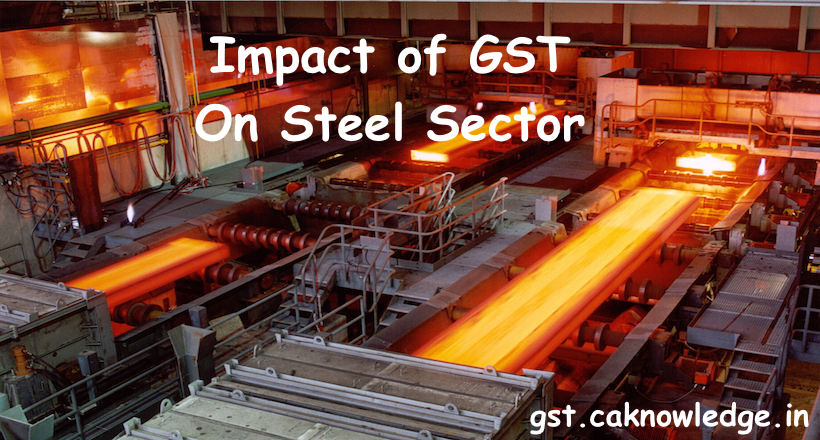Impact of GST on Steel Sector, GST Impact on Steel Industry:andnbsp;Indian steel sector is one of the most leveraged sector hitherto, as being drowning heavily under high debts and no further loans provided to this sector from banks. Plagued by the price reductions at global level in 2015 led to a severe impact on the operating margins of the domestic steel plants and in turn became major contributor to the non-performing assets (NPAs) of the public sector banks. Post GST implementation, we might see a ray of hope to raise this sector from debt trap with deliberate pricing. Iron and steel are major inputs for construction and manufacturing industries and contribute nearly 2% of the country’s Gross Domestic Product (GDP).
Impact of GST on Steel Sector
Existing tax rates on Iron and steel:
From raw input to saleable commodity in the market an iron and steel product has to undergo and carry with its value a few set of taxes as below.
- Excise Duty @ of 12.5%
- Average VAT @ 5%
- Central Sales Tax (CST) @ 5%
Hence, it can be observed that under existing laws a net tax of 19.5% is charged on iron and steel products. Commodities made of iron and steel are also charged at the same rate, except Punjab where VAT rate for commodities of iron and steel is set at 2.5%.
Identifiable Benefits for Iron and Steel Industry from GST:-
- While transporting from one state to another, a cargo has to pass through from levies of various taxes like VAT, excise duties, custom, etc. At every point, corruption emerges and in turn leads to delay in delivering shipment. Because, it takes much time to reach its destination, previously paid taxes adds up indirectly in production cost leaving commodities expensive in the market for end consumers. GST being unified and standard rate of tax will diminish this cost and delay
- Likely benefit of lower tax rate of 5% is expected on major inputs used like coal and iron ore under GST. Further transportation and logistics services are kept under 5% bracket which will raise help in reducing logistic costs.
- Indirectly this reform is also expected to have middleman eradicate from the supply chain in specific states.
- Marginal savings in cost of production, at 18% rate, we can see there shall be a saving of 2%, as against to average of 20% from existing tax rate.
GST portfolio rates in Iron and Steel Industry:
Different rates have been provided for different kind of commodities processed out of iron or steel.
GST at the rate of 12%:
- Sewing Needles
- Animal shoe nails
- Mathematical boxes, geometry boxes, and colour boxes, pencil sharpeners
- Utensils
- Kerosene burners or stoves, wood burning stoves made of iron or steel
- Table or kitchen or other household articles of iron or steel
GST at the rate of 18%:
- All kind of structures used in building bridges, lock gates, roofing and window frameworks, pillars of iron or steel
- Barbed wires used for fencing, cables, ropes made of iron or steel
- All kinds of tubes and pipes made of cast iron and other various tubes and pipes including circular across section the external diameter of which exceeds 406.4mm made of iron or steel
- All kinds of iron and steel used in Railway or tramway tracks
- Reservoir, tanks, casks, drums, cans made of iron or steel
- Sewing needles, knitting needles, and other stuff used in embroidery made of iron or steel not elsewhere specified
- Containers for compressed or liquefied gas made of iron or steel
- Any kind of Sheet
GST at the rate of 28%:
- Sanitary ware and parts thereof made of iron or steel
- Ranges, grates, cookers, barbecues, braziers, gas-rings, plate warmers and similar nonelectric domestic appliances and parts thereof, of iron or steel
- Radiators used in a central heating system and parts thereof made of iron or steel
Advertisement
Know more about GST Rates 2017
International Equality
GST will provide a level playing field to the domestic industry, as the similar GST rates would apply towards imports. Duty that will be levied under GST will be based on the reverse charge method. Being India is signatory to the agreement with international partners countries who are not liable to pay the import duty, they will be subjected to GST at the national level.
Conclusion
In all if steel is used for non-creditable purpose, end user will have to bear this destination based tax. Classification of iron and steel under lower tax bracket would have helped Indian steel industry to compete with China. Also 5% tax on coal will shrink the cost for steel companies as coal is used as inputs by major steel players for their captive power generation. This will also reduce the quantity of spot purchase from previous range of 40%-50% at higher prices. Vigorous credit mechanism and anti-profiteering clause in the GST regime will facilitate to diminish procurement cost.
Key Points:
- Generation new employments.
- No cascading effect.
- Utilization of natural resources
- Logistic cost reduces.
Written By: Amit Khiyani (CA, LCS, IFRS, BCom)
Contact: khiyaniamit88@gmail.com
Recommended Articles
